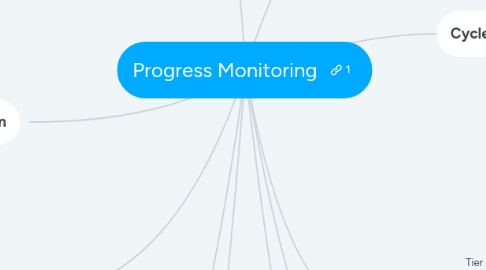
1. Types of Data
1.1. Demographic
1.2. Perception
1.3. Student Learning
1.4. School Process
1.5. Behavior
2. Assessment v. Evaluation
2.1. Assessment - to improve student learning
2.1.1. Assessment of Learning (summative)- Student performance
2.1.2. Assessment for learning (formative)- teacher information to differentiate and adapt to student needs.
2.1.3. Diagnostic Assessments (formative)- illuminate strengths and deficits
2.2. Evaluation - to determine the value or worth of something
3. Balanced Assessment System
3.1. Daily Assignments
3.2. Quizzes
3.3. Test (Summative)
4. Goals
4.1. Group/Individual
4.2. Mastery/Performance-based
4.3. Think SMART
4.3.1. Specific
4.3.2. Measurable
4.3.3. Appropriate
4.3.4. Realistic
4.3.5. Time-bound
4.4. Start at beginning of the year
4.5. Goal Monitoring
4.5.1. Middle of instruction
4.5.1.1. Calculate middle performance
4.5.1.2. Compare actual to expected
4.5.1.3. Monitoring progress to end goal
4.5.1.4. Identify needs based on high and low
4.5.1.5. Maintain and adjust
4.5.1.6. Develop action plan
4.6. Goal Evaluating
4.6.1. Calculate end period performance
4.6.2. Evaluate extent to which goal was met
5. Data Cycles
5.1. 1 - select student's appropriate grade level probe
5.2. 2 - Compute the student's baseline performance
5.3. 3 - Compute the student's end of year goal
5.4. 4 - Evaluate the student's at risk status
5.5. Begin intervention
5.6. 5 - Evaluate impact of the intervention on the student
6. Used to evaluate the effectiveness of an intervention on an individual student and helps us to decide whether the intervention should be continued, discontinued adjusted, or if the student's yearly goal needs to be modified.
7. Cycle of Inquiry
7.1. 1. Absorb
7.1.1. Identify what is known and what needs to be known.
7.2. 2. Ask
7.2.1. Pose questions that will help you understand what needs to be known, if answered.
7.3. 3. Accumulate
7.3.1. Determine if data needed to answer your questions has been collected or if new data is needed.
7.4. 4. Access
7.4.1. Retrieve collected data.
7.5. 5. Analyze
7.5.1. Analyze collected data.
7.6. 6. Answer
7.6.1. Respond to your initial questions and I identify limitations and implications of findings.
7.7. 7. Announce
7.7.1. Communicate findings to appropriate stakeholders.
7.7.1.1. RTI Team
7.8. 8. Apply
7.8.1. Make decisions and take action.
8. Universal Screening
8.1. At least twice a year (normally fall and winter)
8.2. Ensures each student is getting the right level of prevention through RTI
8.3. Criterion-referenced assessment
8.4. Norm-referenced assessment
9. RTI
9.1. Tier 1 - universal intervention (80-90%)
9.1.1. Core curriculum delivered daily in classroom
9.2. Tier 2 - strategic intervention (10-15%)
9.3. Tier 3 - intensive intervention (1-5%)
9.4. Tier 4 - enrichment intervention
9.4.1. 95 percentile +
10. Differentiated Instruction
10.1. Efforts implemented by teacher to address variance in learners.
10.1.1. by environment
10.1.2. by products
10.1.2.1. means by which
10.1.3. by content
10.1.3.1. information
